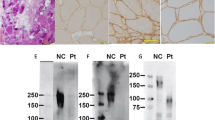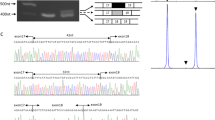Abstract
Limb-girdle muscular dystrophies (LGMD) are a heterogeneous group of inherited neuromuscular disorders characterized by proximal muscular weakness of the pelvic and shoulder girdles and a variable progression with symptoms, ranging from very severe to mild1,2. One autosomal dominant (LGMD1 A, at chromosome 5q22.3–31.3) (ref. 3) and five autosomal recessive (AR) loci responsible for this phenotype have been identified: LGMD2A at 15q (ref. 4); LGMD2B at 2p (ref. 5), LGMD2C at 13q (ref. 6), LGMD2D at 17q (ref. 7) and LGMD2E at 4q (refs 8, 9). In the muscle membrane, dystrophin associates with several proteins and glycoproteins organized in two main subcomplexes: the dystroglycan (DG) and sarcoglycan (SG) complexes9, 10–14. The genes for LGMD2C, LGMD2D and LGMD2E code for proteins of the SG complex7, 8, 15–17. We recently mapped a sixth AR form of LGMD, LGMD2F, to chromosome 5q33–3418 in two Brazilian families. In the same chromosomal interval we also mapped the δSG gene, encoding a novel 35-kD component of the sarcoglycan (SG) complex19. We now show that a homozygous mutation in the δSG gene (a single nucleotide deletion that alters its reading frame) is the cause of LGMD2F.
This is a preview of subscription content, access via your institution
Access options
Subscribe to this journal
Receive 12 print issues and online access
$209.00 per year
only $17.42 per issue
Buy this article
- Purchase on Springer Link
- Instant access to full article PDF
Prices may be subject to local taxes which are calculated during checkout
Similar content being viewed by others
References
Bushby, K.M.D. & Beckmann, J.S. The limb-girdle muscular dystrophies — proposal for a new nomenclature. Neuromusc, Disord. 5, 337–343 (1995).
Walton, J.N. & Gardner-Medwin, D. The muscular dystrophies. in Disorders of voluntary muscle. (5th edn. ed. John Walton, Churchill Livingstone, 1988).
Speer, M. et al. Confirmation of genetic heterogeneity in limb-girdle muscular dystrophy:linkage of an autosomal dominant form to chromosome5q. Am. J. Hum. Genet. 50, 1211–1217 (1992).
Beckmann, J.S. et al. A gene for limb-girdle muscular dystrophy maps to chromosome 15 by linkage analysis. C.R. Acad. Sci. Paris t312, 141–148 (1991).
Bashir, R. et al. A gene for autosomal recessive limb-girdle muscular dystrophy maps to chromosome 2p. Hum.Mol. Genet. 3, 455–457 (1994).
Othmane, K.B., Ben Hamida, M., Pericak-Vance, M.A., Ben Hamida, C., Blel, S. & Carter, S.C. Linkage of Tunisian autosomal recessive Duchenne-like muscular dystrophy to the pericentromeric region of chromosome 13q. Nature Genet. 2, 316–317 (1992).
Roberds, S.L. et al. Missense mutations in the adhalin gene linked to autosomal recessive muscular dystrophy. Cell 78, 625–633 (1994).
LE.et al. β-sarcoglycan: characterization and role in limb-girdle muscular dystrophy linked to 4q12. Nature Genet. 11, 257–265 (1995).
Bönnemann, C.G. et al. β-sarcoglycan: (A3b) mutations cause autosomal recessive muscular dystrophy with loss of the sarcoglycan complex. Nature Genet. 11, 266–273 (1995).
Campbell, K.R. Three muscular dystrophies: loss of cytoskeleton-extracellular matrix linkage. Cell 80, 675–679 (1995).
Ozawa, E. Dystrophin-associated proteins in muscular dystrophy. Hum. Mol. Genet. 4, 1711–1716, (1995).
Worton, R. Muscular dystrophies: diseases of the dystrophin-glycoprotein complex. Science 270, 755–756 (1995).
Yoshida, M., Suzuki, A., Yamamoto, H., Noguchi, S., Mizuno, Y. & Ozawa, E. Dissociation of the complex of dystrophin and its associated proteins into several unique groups by n-octyl beta-D-glucoside. Eur. J. Biochem. 222, 1055–1061 (1994).
Ibraghimov-Beskrovnaya, O., Milatovich, A., Ozcelik, T., Yang, B., Koepnick, K. & Francke, U., Campbell, K.P. Human dystroglycan: skeletal muscle cDNA, genomic structure, origin of tissue-specific isoforms and chromosomal localization. Hum. Mol. Genet. 2, 1651–1657 (1993).
Noguchi, S. et al. Mutations in the dystrophin-associated protein g-sarcoglycan in chromosome 13 muscular dystrophy. Science 270, 819–822 (1995).
Roberds, S.L., Anderson, R.D., Ibraghimov-Beskrovnaya, O. & Campbell, K.R. Primary structure and muscle-specific expression of the 50-kDa dystrophin-associated glycoprotein (adhalin). J. Biol. Chem. 268, 23739–23742 (1993).
McNally, E.M., Yoshida, M., Mizuno, Y., Ozawa, E. & Kunkel, L.M. Human adhalin is alternatively spliced and the gene is located on chromosome 17q21. Proc. Natl. Acad. Sci. USA 91, 9690–9694 (1994).
Passos-Bueno, M.R., Moreira, E.S., Vainzof, M., Marie, S.K. & Zatz, M. Linkage analysis in autosomal recessive limb-girdle muscular dystrophy (AR LGMD) maps a sixth form to 5q33-34 (LGMD2F) and indicates that there is at least one more subtype of AR LGMD. Hum. Mol. Genet. 5, 815–821 (1996).
Nigro, V. et al. Identification of a novel sarcoglycan gene at 5q33 encoding a sarcolemmal 35 kDa glycoprotein. Hum. Mol. Genet. 5, 1179–1186 (1996).
Richard, I. et al. Mutations in the proteolytic enzime calpain 3 cause limb-girdle muscular dystrophy type 2A. Cell 81, 27–40 (1995).
Passos-Bueno, M.R. et al. Main clinical features for the three mapped autosomal recessive limb-girdle muscular dystrophies and estimated proportion of each form in 13 Brazilian families. J. Med. Genet. 33, 97–102 (1996).
Passos-Bueno, M.R. et al. A common missense mutation in the adhalin gene in three unrelated Brazilian families with a relatively mild form of autosomal recessive limb-girdle muscular dystrophy. Hum. Mol. Genet. 4, 1163–1167 (1995).
Nigro, V., Politano, L., Nigro, G., Colonna-Romano, S., Molinari, A.M. & Puca, G.A. Detection of a nonsense mutation in the dystrophin gene by multiple SSCP. Hum. Mol. Genet. 1, 517–520 (1992).
Vainzof, M. et al. Immunofluorescence dystrophin study in Duchenne dystrophy through the concomitant use of two antibodies directed against the carboxy-terminal and the amino-terminal region of the protein. J. Neuroi. Sci. 101, 141–147 (1991).
Author information
Authors and Affiliations
Rights and permissions
About this article
Cite this article
Nigro, V., Moreira, E., Piluso, G. et al. Autosomal recessive limbgirdle muscular dystrophy, LGMD2F, is caused by a mutation in the δ–sarcoglycan gene. Nat Genet 14, 195–198 (1996). https://doi.org/10.1038/ng1096-195
Received:
Accepted:
Issue Date:
DOI: https://doi.org/10.1038/ng1096-195
This article is cited by
-
The role of the dystrophin glycoprotein complex in muscle cell mechanotransduction
Communications Biology (2022)
-
Molecular and cellular basis of genetically inherited skeletal muscle disorders
Nature Reviews Molecular Cell Biology (2021)
-
A Journey with LGMD: From Protein Abnormalities to Patient Impact
The Protein Journal (2021)
-
The ties that bind: functional clusters in limb-girdle muscular dystrophy
Skeletal Muscle (2020)
-
Pigs with δ-sarcoglycan deficiency exhibit traits of genetic cardiomyopathy
Laboratory Investigation (2020)



